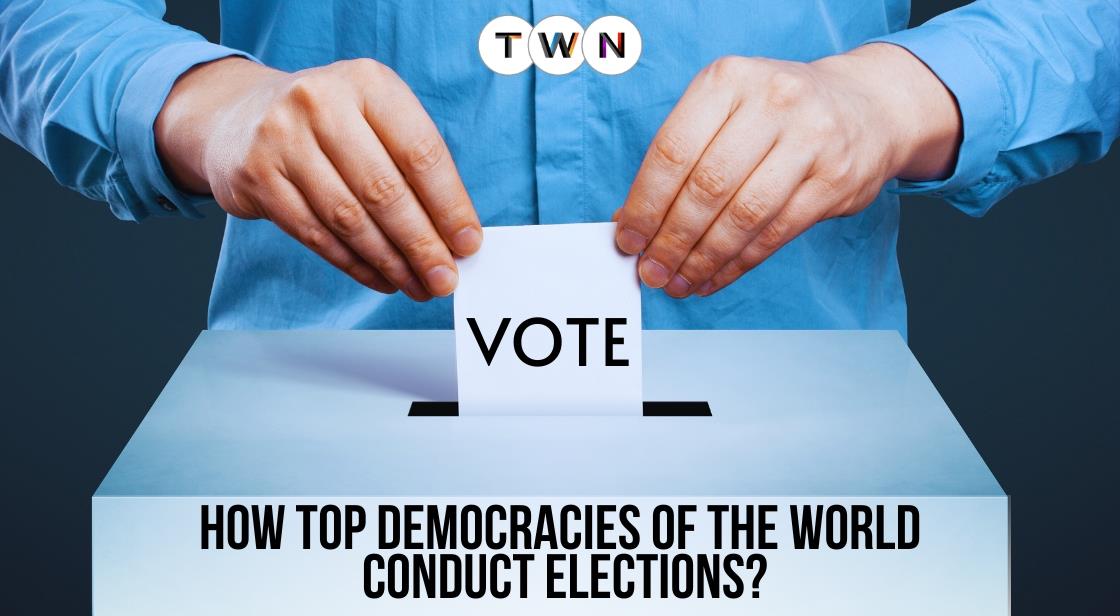How Top Democracies of the World Conduct Elections?

Blog Post
The electoral processes in top democracies around the world represent a diverse spectrum of methodologies and practices aimed at ensuring fair representation and democratic governance.
These nations, which include established democracies like the United States, the United Kingdom, Germany, and others, have developed sophisticated systems for conducting elections that reflect their unique historical, cultural, and institutional contexts.
At the heart of these electoral systems lies the fundamental principle of citizen participation, wherein individuals exercise their right to vote and choose their leaders and representatives. Whether through direct or indirect voting mechanisms, these democracies provide avenues for citizens to voice their preferences and shape the trajectory of their nations.
Key features of electoral processes in top democracies include the use of various voting systems such as first-past-the-post, proportional representation, and mixed-member proportional representation. Additionally, the presence of independent electoral commissions or bodies ensures the integrity and fairness of elections, overseeing crucial aspects like voter registration, ballot counting, and resolving disputes.
Moreover, advancements in technology have introduced innovations like electronic voting machines and online voter registration systems, streamlining the voting process and enhancing accessibility for citizens.
In essence, the manner in which top democracies conduct their elections reflects a commitment to democratic values and principles, seeking to uphold the rights of citizens and maintain the legitimacy of governance through transparent and inclusive electoral practices.
Understanding Electoral Procedures in Leading Democratic Nations
1. United States of America: The Electoral College System
Overview of the Electoral College System in U.S.A
-
The Electoral College is a distinctive electoral system utilized by the United States for the selection of the President and Vice President.
-
Instead of a direct popular vote, voters indirectly elect these officials through electors chosen by each state.
Indirect Election Process in U.S.A:
-
Voters in each state cast their ballots for a slate of electors pledged to a particular presidential candidate.
-
These electors, equal in number to the state's representation in Congress, then formally cast their votes for President and Vice President.
Combination of Popular Vote and Electoral Votes:
-
The Electoral College process involves a combination of the popular vote and electoral votes.
-
Each state is allocated a certain number of electoral votes based on its representation in Congress, including both senators and representatives.
Allocation of Electoral Votes:
-
The number of electoral votes for each state is determined by the total number of representatives and senators it has in Congress.
-
Larger states typically have more electoral votes due to their larger congressional delegations.
Scrutiny and Debate:
-
The Electoral College system has been the subject of scrutiny and debate.
-
Critics argue that it can lead to discrepancies between the popular vote and electoral outcomes, potentially resulting in presidents who did not win the national popular vote.
Reform Proposals:
-
Over the years, various reform proposals have been suggested to modify or replace the Electoral College system.
-
These include the direct popular vote method and proportional allocation of electors based on the popular vote in each state.
Constitutional Basis:
-
The Electoral College system is rooted in the U.S. Constitution, specifically in Article II, Section 1, and the Twelfth Amendment.
-
It reflects the Founding Fathers' compromise between election by Congress and election by popular vote.
Impact on Presidential Elections:
-
The Electoral College system plays a crucial role in determining the outcome of presidential elections in the United States.
-
Candidates focus their campaign strategies on winning states with a significant number of electoral votes, known as battleground or swing states.
Conclusion:
-
Despite its complexities and controversies, the Electoral College remains a fundamental aspect of the U.S. electoral process, shaping the dynamics of presidential elections and influencing political strategies.
2. United Kingdom: First Past the Post Voting
Overview of the FPTP System In U.K
-
Elections in the United Kingdom utilize the First Past the Post (FPTP) voting system.
-
Under FPTP, parliamentary seats are awarded to the candidate with the most votes in each constituency.
Absence of Absolute Majority Requirement:
-
FPTP does not mandate an absolute majority for a candidate to win a parliamentary seat.
-
Instead, the candidate with the highest number of votes, even if less than 50%, secures the seat.
Potential for Disproportionate Results:
-
One criticism of FPTP is its tendency to produce disproportionate outcomes.
-
Smaller parties may struggle to secure representation in Parliament, even if they garner a significant share of the national vote.
Lack of Proportional Representation:
-
FPTP prioritizes constituency-level victories over national vote share.
-
As a result, the distribution of parliamentary seats may not accurately reflect the overall preferences of voters across the country.
Criticisms and Debates:
-
Critics argue that FPTP can lead to wasted votes and disenfranchise voters who support minority parties.
-
Calls for electoral reform, including the adoption of proportional representation, have been raised to address perceived shortcomings of the FPTP system.
Historical Context and Continuation:
-
FPTP has been the dominant electoral system in the UK for centuries.
-
Despite ongoing debates about its fairness and efficacy, FPTP remains in use for general elections and local elections in England and Wales.
Conclusion:
-
While FPTP offers simplicity and clarity in determining constituency-level winners, its lack of proportionality and potential for disproportionate outcomes have fueled ongoing discussions about electoral reform in the United Kingdom.
Also Read: Understanding the Concept and Characteristics of Indian Democracy
3. Germany: Mixed-Member Proportional Representation System
Overview of Mixed-Member Proportional (MMP) In Germany
-
Germany utilizes a Mixed-Member Proportional (MMP) representation system for its federal elections.
-
This system is designed to balance both constituency representation and overall proportionality in the legislature.
Voting Process in Germany:
Voters cast two votes:
-
One for a constituency candidate.
-
Another for a political party.
-
The first vote determines the winner in each electoral district, similar to a first-past-the-post system.
-
The second vote is for a political party, influencing the proportional distribution of seats in the Bundestag.
Allocation of Seats:
-
Seats in the Bundestag are allocated based on the party vote proportionally.
-
Additional seats are allocated to ensure proportional representation, balancing out any discrepancies between the party vote and the seats won in individual constituencies.
Constituency Representation:
-
Constituency candidates who win their districts through the first vote represent their specific geographic areas in the Bundestag.
-
This ensures that regional interests are adequately represented in the legislative process.
Proportional Representation:
-
The party vote determines the overall composition of the Bundestag, ensuring that parties receive seats in proportion to their share of the national vote.
-
This promotes fairness and inclusivity in the representation of political ideologies and viewpoints.
Benefits of MMP:
-
MMP allows for a balance between direct representation through constituency candidates and proportional representation based on party votes.
-
It encourages a diverse range of political parties and ensures that smaller parties have a chance to be represented in the legislature.
Conclusion:
-
Germany's Mixed-Member Proportional Representation system exemplifies a nuanced approach to electoral representation, combining elements of both constituency-based and proportional voting systems.
-
By striking a balance between local representation and overall proportionality, MMP fosters a robust and inclusive democratic process in Germany.
4. France: Two-Round System
Overview of Two-Round System In France
-
France employs a Two-Round System for both presidential and legislative elections.
-
The electoral process consists of two distinct rounds aimed at determining a clear winner.
First Round:
-
In the initial round, voters cast their ballots for various political parties and candidates.
-
All candidates who receive more than 12.5% of the votes from registered voters proceed to the second round.
-
If only two candidates surpass this threshold, they automatically qualify for the runoff.
Second Round (Runoff Election Mechanism):
-
The top two candidates from the first round advance to a runoff election.
-
This ensures that the winning candidate ultimately garners majority support from the electorate.
Criticisms of the System:
-
Despite its effectiveness in determining a clear winner, the Two-Round System has faced criticism.
-
One major criticism is its potential to exclude smaller parties from contention in the second round, thereby limiting political diversity and representation.
Impact on Political Dynamics:
-
The Two-Round System influences campaign strategies, with candidates often focusing on securing a place in the runoff.
-
It encourages strategic voting, as voters may strategically support candidates perceived to have a better chance in the second round.
Ensuring Majority Support:
-
By requiring the winning candidate to secure majority support, the Two-Round System aims to enhance legitimacy and mandate.
Electoral Outcomes:
-
The system has historically led to decisive electoral outcomes, with winners enjoying broad support from the electorate.
-
However, it also poses challenges in terms of representation for smaller parties and may lead to polarization between the top two candidates.
Role in French Democracy:
-
Despite criticisms, the Two-Round System plays a crucial role in French democracy, ensuring that elected officials have the backing of a significant portion of the population.
Potential Reforms and Debates:
-
Debates surrounding potential reforms to the electoral system continue, with discussions focusing on ways to enhance representation while maintaining the system's ability to determine majority support.
Conclusion:
-
Overall, the Two-Round System in France serves as a key component of the country's democratic process, though it is not without its shortcomings.
-
As France navigates evolving political dynamics, ongoing debates surrounding electoral reform will shape the future of its electoral system.
5. Canada: Single Member Plurality System
Overview of the SMP System in Canada:
-
Canada utilizes the Single Member Plurality (SMP) system, also known as First Past the Post, for its federal elections.
-
Under this system, each electoral district (riding) elects one representative to Parliament.
-
The candidate with the most votes in each riding wins the parliamentary seat, regardless of whether they secure an absolute majority.
Similarities to the UK System:
-
The SMP system in Canada shares similarities with the electoral system used in the United Kingdom.
-
Both systems prioritize constituency representation and award seats to the candidate with the most votes in each riding.
Criticisms of the SMP System:
-
Despite its simplicity and familiarity to Canadian voters, the SMP system has faced criticism.
-
One notable criticism is its tendency to produce majority governments with less than a majority of the popular vote.
-
This discrepancy between seats won and popular vote share has raised concerns about the system's fairness and representativeness.
Impact on Governance:
-
The SMP system has significant implications for the composition and functioning of the Canadian government.
-
It often leads to a concentration of power in the hands of the winning party, allowing them to form majority governments with a relatively small share of the overall vote.
-
This can result in limited representation for smaller parties and regions, potentially exacerbating feelings of political disenfranchisement.
Public Discourse and Reform Efforts:
-
The shortcomings of the SMP system have sparked public discourse and calls for electoral reform in Canada.
-
Various alternative electoral systems, such as proportional representation, have been proposed as potential alternatives to address the perceived deficiencies of the SMP system.
-
However, the debate surrounding electoral reform remains complex, with differing opinions on the most appropriate course of action to ensure fair and effective representation in Canadian democracy.
Conclusion:
-
While the SMP system has served as the cornerstone of Canada's electoral process for decades, its limitations have prompted discussions about potential reforms.
-
As Canada continues to evolve as a democratic nation, the ongoing debate over electoral systems reflects a commitment to strengthening the foundations of representative governance and ensuring that the voices of all citizens are heard and valued.
6. India: First Past the Post in a Parliamentary Democracy
Overview of India's Electoral System
India, as the world's largest democracy, employs the First Past the Post (FPTP) system for its parliamentary elections.
-
FPTP is a simple plurality voting method where the candidate with the highest number of votes in each constituency wins the seat, regardless of whether they achieve an absolute majority.
Electoral Process in India:
Universal Suffrage and Constitutional Adoption:
-
India achieved universal suffrage after adopting the Indian Constitution in 1950.
-
Adult citizens aged 18 and above, not otherwise debarred from voting, can exercise their right to the franchise.
Election of Lok Sabha Members:
-
Voters elect a 544-member Lok Sabha (House of the People) from single-member constituencies.
-
Each state follows a similar system for electing members to the Lok Sabha.
Indirect Election of Rajya Sabha and State Upper Houses:
-
The Rajya Sabha (Council of States), the upper house of parliament, and corresponding state upper houses are indirectly elected.
-
Members of state legislative assemblies elect representatives to the Rajya Sabha and state upper houses.
Frequency of General Elections:
-
General elections occur once every five years.
-
The President may dissolve the Lok Sabha earlier if advised by the Prime Minister or if no stable government can be formed.
Tenure of Prime Minister:
-
The Prime Minister holds office as long as they can command a majority in the Lok Sabha.
-
In case of a loss of majority support, the Prime Minister may be required to resign.
Challenges in the Electoral Process:
-
While the electoral process is widely regarded as free and fair, challenges persist in certain rural pockets.
-
Challenges include instances of voter suppression, polling station captures, and flouting of candidate spending limits.
-
Efforts are ongoing to address these challenges and ensure the integrity and fairness of the electoral process throughout the country.
Direct Representation of Constituents:
-
FPTP allows for direct representation of constituents, as voters choose their preferred candidate to represent them in Parliament.
-
This direct link between voters and their representatives is a fundamental aspect of democratic governance.
Challenges Posed by FPTP:
-
Fragmented Mandates: FPTP may lead to fragmented mandates, where multiple parties win seats in Parliament but none have a clear majority.
-
Underrepresentation of Minority Voices: FPTP has been criticized for potentially underrepresenting minority voices, as candidates who win by plurality may not truly reflect the diversity of opinions within a constituency.
Impact on India's Political Landscape:
-
FPTP has shaped India's political landscape, influencing the strategies of political parties and the dynamics of electoral competition.
-
Political parties often focus on winning a plurality of votes in key constituencies rather than aiming for broad-based support across the country.
Conclusion:
-
Despite its challenges, India's use of the FPTP system underscores the country's commitment to democratic principles and electoral participation.
-
As India continues to evolve politically, discussions about electoral reform and the efficacy of FPTP in representing diverse voices remain pertinent.
7. Australia's Electoral System: Preferential Voting and Proportional Representation
Overview Preferential Voting System in Australia:
-
Voters rank candidates in order of preference.
-
Ensures that the winning candidate secures majority support.
-
Allows voters to express their preferences beyond their first choice.
-
Minimizes the likelihood of wasted votes and encourages broader participation.
Proportional Representation in Senate Elections:
-
Utilized in Australia's Senate elections.
-
Enables a more diverse range of political representation.
-
Allocates seats based on the proportion of votes received by each party.
-
Ensures that minority viewpoints are adequately represented in the legislature.
-
Promotes inclusivity and reflects the diversity of Australian society.
Balancing Majority Rule and Proportional Representation:
-
Australia's electoral system aims to strike a balance between majority rule and proportional representation.
-
Preferential voting ensures that the winning candidate has broad-based support, enhancing legitimacy.
-
Proportional representation in Senate elections fosters inclusivity and ensures that all voices are heard in the legislative process.
-
By combining these two methods, Australia seeks to uphold democratic principles while accommodating the diversity of its electorate.
Advantages of the Australian Electoral System:
-
Encourages political engagement and participation.
-
Provides voters with greater choice and flexibility.
-
Enhances the representation of diverse viewpoints in the government.
-
Facilitates the formation of coalition governments that reflect the broader spectrum of public opinion.
-
Strengthens the democratic legitimacy of elected representatives and institutions.
Conclusion:
-
Australia's electoral system, characterized by preferential voting and proportional representation, exemplifies a commitment to democratic values and principles.
-
By prioritizing majority support while also ensuring proportional representation, Australia seeks to create a more inclusive and representative democracy.
-
This unique combination of electoral mechanisms reflects the country's ongoing efforts to evolve and adapt its democratic institutions to meet the needs of its citizens.
Also Read: Buddhism and the Path to Global Peace: A War-Free World
8. Russia's Electoral Process: Mixed Electoral System
Overview Mixed Electoral System in Russia
-
Russia's electoral process encompasses presidential, parliamentary, and regional/local elections.
-
Each election level has its own specific procedures and dynamics, contributing to the overall democratic framework of the country.
Presidential Elections System in Russia:
-
Direct popular vote determines the Russian president.
-
Conducted in a two-round majoritarian contest.
-
If no candidate secures over 50% in the first round, a run-off occurs.
-
The run-off takes place exactly three weeks after the initial vote.
Federal Assembly Elections System in Russia:
Comprises two chambers: the State Duma and the Federation Council.
State Duma:
-
450 members elected for five-year terms.
-
Half elected through proportional representation party list voting (5% threshold).
-
Half elected through majority voting (one deputy per constituency).
Federation Council:
-
Consists of 208 members, not directly elected.
-
Each of the 89 federal subjects of Russia sends 2 delegates.
Parliamentary Elections:
-
Historical dominance by the Communist Party in 1995 and 1999 elections.
-
Secured 35% and 24% of votes, respectively.
Other significant parties include:
-
Liberal Democratic Party of Russia (vote percentages ranging from 5% to 15%).
-
Yabloko (10% in 1995, approximately 5% in subsequent elections).
-
United Russia emerged as the largest party in 2003 with 38% of the vote.
Regional and Local Elections:
-
Conducted across Russia's 89 subjects of federation.
-
Include oblasts, republics, autonomous territories, and autonomous okrugs.
Voters elect:
-
Regional parliaments.
-
Governors (directly or indirectly).
-
Local councils in towns and cities.
9. Japan: Mixed-Member Proportional Representation
Overview of Mixed-Member Proportional Representation in Japan:
-
Japan employs a Mixed-Member Proportional (MMP) representation system for its House of Representatives elections.
-
MMP combines elements of both constituency-based and proportional representation systems to ensure a balance between local and national interests.
Dual Voting System:
-
Voters in Japan cast two votes: one for a constituency candidate and another for a political party.
-
The first vote determines the winner in individual constituencies, while the second vote contributes to the overall proportional allocation of seats to parties.
Proportional Allocation of Seats:
-
Seats in the House of Representatives are allocated proportionally based on the party vote received nationwide.
-
Parties receive additional seats to ensure that the overall composition of the legislature reflects the proportion of votes cast for each party.
Balancing Local Representation and National Proportionality:
-
The MMP system aims to strike a balance between local representation and national proportionality.
-
Constituency-based voting ensures that constituents are represented by a local candidate, while proportional allocation of seats ensures that parties are represented in proportion to their overall support nationwide.
Ensuring Overall Proportionality:
-
Additional seats are allocated to parties based on their proportional vote share to ensure that the final composition of the House of Representatives reflects the overall distribution of votes.
-
This mechanism helps prevent discrepancies between the popular vote and the distribution of seats, promoting fairness and representation in the legislative process.
Conclusion:
-
Japan's Mixed-Member Proportional Representation system embodies the country's commitment to balancing local representation with national proportionality.
-
By combining elements of both constituency-based and proportional representation, MMP aims to foster a diverse and representative legislature that effectively reflects the will of the electorate.
10. China Electoral System: A Unique Model
China's electoral system is defined by its centralized authority, limited political diversity, and emphasis on stability and party control, reflecting the unique characteristics of the country's political structure.
Overview of Hierarchical Legislative System in China:
-
China's People's Congresses operate in a hierarchical structure, spanning local to national levels.
-
They serve as the primary legislative bodies responsible for enacting laws and making decisions on behalf of the populace.
Local Level Congresses:
-
People's Congresses are established in provinces, municipalities, counties, and other administrative regions.
-
These local congresses address issues and make decisions directly impacting their respective jurisdictions.
Direct and Indirect Elections:
Direct Elections: Citizens participate in direct elections to choose deputies for local-level People's Congresses.
Indirect Elections: Deputies to higher-level congresses, including the National People's Congress (NPC), are elected by lower-level congresses, creating an indirect electoral process.
President of the State:
-
The President of the People's Republic of China is elected by the NPC, the highest legislative body in the country.
-
However, the role of the President is largely ceremonial, with the Communist Party of China (CPC) holding the real power.
One-Party System In China:
-
China operates under a one-party system, with the Communist Party of China (CPC) as the sole ruling party.
-
The CPC exerts control over all political aspects, and there are no openly contested national elections.
Lack of Political Pluralism:
-
China's political landscape lacks political pluralism, unlike multi-party systems found in Western democracies.
-
Citizens do not have the option to choose between different political parties or ideologies through competitive elections.
Conclusion: Diversity and Evolution of Electoral Systems
In conclusion, the electoral processes of top democracies exhibit a remarkable diversity of methods and approaches. From the Electoral College system in the United States to the preferential voting system in Australia, each country has developed its own unique system tailored to its historical, cultural, and political context.
While these systems have their strengths and weaknesses, they all share the common goal of ensuring the democratic expression of the will of the people. As democracy continues to evolve, so too will the methods by which elections are conducted, reflecting the changing needs and aspirations of societies around the world.
You May Like
EDITOR’S CHOICE












